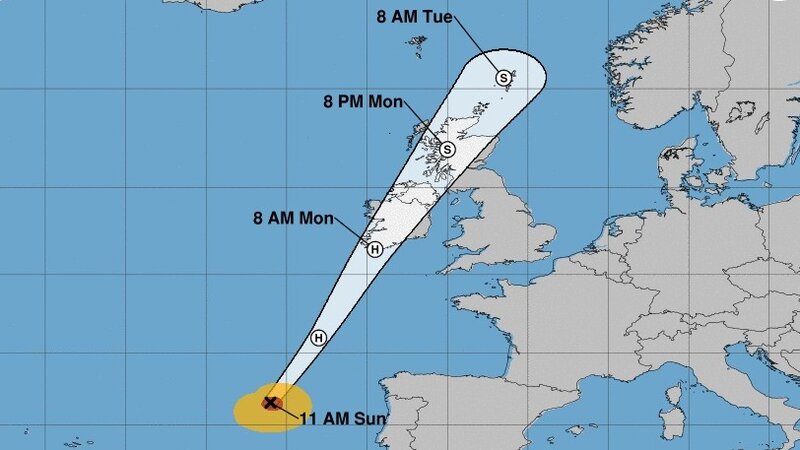Already A Historic Storm, Weakening Ophelia Draws A Bead On British Isles
By Colin Dwyer

Already A Historic Storm, Weakening Ophelia Draws A Bead On British Isles
By Colin DwyerUpdated at 11:40 p.m. ET
Hurricane season isn’t through with us yet.
After Harvey, Irma and Maria wrought their destruction in quick succession, inundating southeast Texas and steamrolling much of the Caribbean, another big storm has taken shape in the Atlantic Ocean: Ophelia. Only this time, the post-tropical cyclone that peaked as a Category 3 hurricane over the weekend is sweeping eastward, heading toward the British Isles, where it’s expected to make landfall on Monday.

By the latest estimates from the National Hurricane Center in the U.S., Ophelia is likely to make landfall in Ireland on Monday morning. (National Hurricane Center)
“This will be a significant weather event for Ireland with potentially high impacts — structural damage and flooding (particularly coastal) — and people are advised to take extreme care,” Met Éireann, the Irish meteorological service, said in a statement Saturday.
#Ophelia is now a major hurricane - the farthest east (26.6°W) an Atlantic major hurricane has existed on record. pic.twitter.com/RfdDdUqI5h
— Philip Klotzbach (@philklotzbach) October 14, 2017
As of late morning Sunday, the U.S. National Hurricane Center said Ophelia packed maximum sustained winds of about 90 mph. The service expected the storm to continue to weaken over the next 24 to 48 hours as it churned over colder waters on its way to Ireland and the U.K.
Still, the storm has already made history. As noted by Philip Klotzbach, meteorologist at Colorado State University, Ophelia reached Category 3 status Saturday — making it “the farthest east (26.6W) an Atlantic major hurricane has existed on record” before it weakened to a Category 1 storm on Sunday.
An amber wind warning is in force across Northern Ireland for tomorrow. Stay #weatheraware here: https://t.co/EFVGlpF0N1 pic.twitter.com/CmJ6SNHa0J
— Met Office (@metoffice) October 15, 2017
Met Éireann attributed the hurricane’s unprecedentedly strong eastward lurch to “exceptionally warm temperatures in western Europe.”
Despite the likelihood Ophelia will still wane in strength before reaching land, authorities have been sparing few precautions. Officials have issued a red warning and closed schools throughout at least eight counties in Ireland, according to the BBC. And Irish Prime Minister Leo Varadkar tweeted Sunday that defense forces are being deployed to those areas, as well.
In its advisory issued Sunday morning, the National Hurricane Center said it expects the storm to “maintain hurricane force winds until it reaches Ireland” on Monday morning, then diminish significantly as it moves northeast through Northern Ireland and Scotland later in the day.
Copyright 2017 NPR. To see more, visit http://www.npr.org/.
9(MDI4ODU1ODA1MDE0ODA3MTMyMDY2MTJiNQ000))

